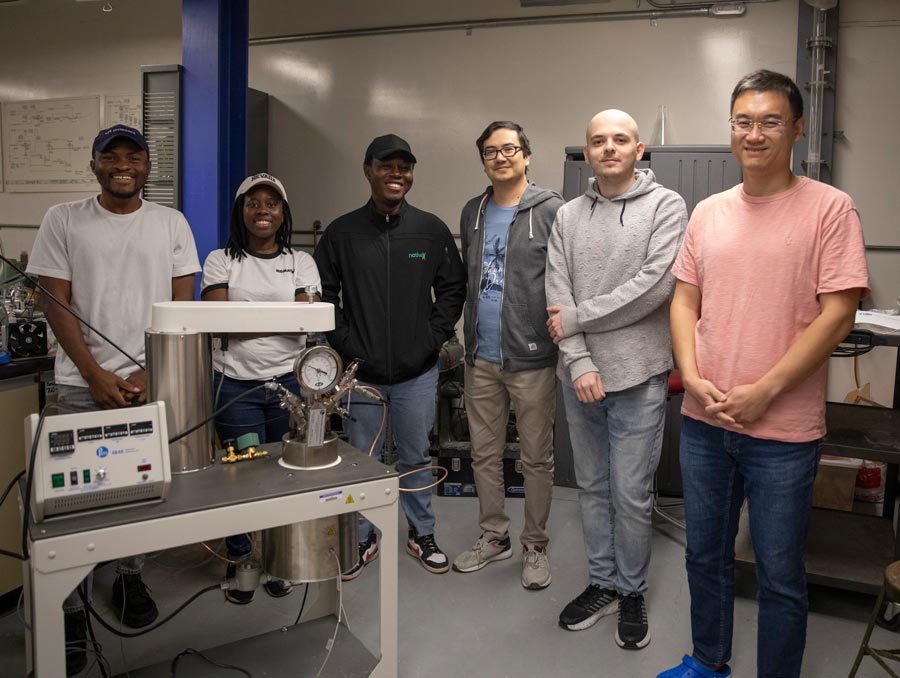Can material leftover from mining lithium be used to store carbon? That’s the question Nevada Gold Mines Professor Pengbo Chu will be pursuing in his research lab with support from Lithium Americas.
Lithium Americas is a chemical production company aiming to extract and process lithium on site in northern Nevada. The end product will be pure lithium carbonate that can be used to make electric car batteries, supporting the green energy transition from fossil fuels to renewable energy.
“A natural fit”
“We're in the carbon reduction business by virtue of the product we make,” said Tim Crowley ‘92 (geography), Vice President of Government Affairs and Community Relations at Lithium Americas. “[The lithium] is designed to be put into batteries to help bring down carbon emissions. We should do everything we possibly can to make sure our carbon footprint is as low as possible while we're making this product. It just doesn't make sense for the battery industry to be a big carbon emitter in the pursuit of bringing down carbon emissions.”
Chu, whose research is focused on mineral processing techniques, reached out to Lithium Americas with a project idea aimed at finding ways to mitigate the company’s carbon emissions. The goal of the project is to store carbon dioxide in the waste produced after processing the mined material.
“We've had a lot of talks over the past with Pengbo on potential projects and it was an idea that was sparked by one of those conversations,” said Ryan Ravenelle ‘06 (chemical engineering), Manager of Research and Development at Lithium Americas. “Pengbo has the capability and the expertise in the area. We have the material, and we have the CO2. So, it's a natural fit.”
Sequestering carbon
Lithium Americas will mine and process lithium that’s bound in clay, and Crowley said they are the first company to ever do so. The process will involve extracting lithium from the clay with sulfuric acid and then turning it into a high purity chemical. The clay also naturally contains carbonates which form carbon dioxide during the reaction with acid, but Chu and the engineers at Lithium Americas are developing methods to capture that carbon and store it in the waste products by two mechanisms: chemical sequestration and physical sequestration.
The prerequisite to either sequestration option, Chu said, is to have the suitable minerology. Having the right material inputs to store the carbon, like the magnesium silicate-rich clay found at the mine site, is promising. There are several options for carbon sequestration at the site.
“One option is in the tailings, which is clay that has been processed and most of the lithium has been removed,” said Crowley. “That material is stored on-site and available for carbon sequestration.”
The material that goes through processing presents challenges for carbon storage because of the chemical changes it went through, but other options for storing the carbon remain.
“There's additional opportunity for sequestration in the waste material,” Crowley said. “Waste is simply earthen material that does not have economically viable amounts of lithium. Waste material is extracted from the pit but not processed. It, too, could potentially be used for carbon storage, and we're doing a deep analysis of that. Chu said that there have been attempts to do this in the past, so there is proof of concept.
“It’s time to analyze larger samples of waste material from Thacker Pass,” Crowley said.
Another aspect of the study, Chu said, is to use the carbon dioxide to potentially extract even more lithium out of lower-concentration material. The combination of carbon dioxide storage in tailings and waste, and using carbon dioxide to increase lithium recovery, presents many significant benefits that could dramatically reduce carbon emissions from the site.
A relationship forged over time
“I really appreciate the company being very open-minded,” Chu said.
Chu added that the open sharing of information between his research group and Lithium Americas has been critical to developing this project. Lithium Americas has provided Chu with samples from various parts of the mine. Different layers and parts of the mine will have different minerology, so there will be natural variations in how the CO2 can be used. The research up to date has found some materials from the mines that can react with CO2, but the mineralogy change is complex. Continuous research will be required to understand the fundamental science. The research findings thus far establish strong confidence that there is a potential to make carbon sequestration with lithium mining work.
“I think it would be quite novel,” said Ravenelle. “I’m not aware of any other projects that are trying to sequester or mineralize CO2 in their waste products.”
Furthermore, many of the clays in mines in Nevada are magnesium rich.
“If the deposit has the required minerology, the knowledge learned from this project can be transferred to other projects,” Chu said.
Chu said that if other faculty members are interested in pursuing research projects like this with companies, there has to be relationship-building from both parties. This project was developed after several years of conversation with Lithium Americas, and the candid conversations helped both parties understand the goals of one another.
“It's very fortunate that Pengbo brought this idea to us,” said Crowley. “For him to come to us and say, ‘We'd like you to explore ways to further reduce your carbon footprint,’ that’s great stuff, and we appreciate his initiative.”
















